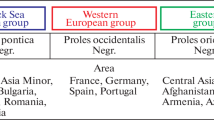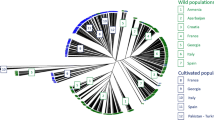Abstract
Palestine has a wide range of agro-ecological concerns and hosts a large variety of plants. Grapes are part of the cultural heritage and provide an indispensable food ingredient. Local cultivars have been traditionally identified on the basis of morphological traits, geographical origin, or names of the vineyard owner; therefore, the occurrence of homonymy, synonymy, and misnaming significantly prevents their valorization. DNA profiling by 22 common SSR markers was used to characterize 43 putative cultivars grown mainly for local table grape consumption at the southern highland regions of West-Bank, to further evaluate genetic diversity and relationships of the population. Consistent matching of SSR markers with grapevines cultivated in neighboring countries or maintained in European germplasm collections was found for 8 of the 21 different non-redundant genotypes discovered, suggesting possible synonyms as well as the occurrence of breeding selections formerly developed in the USA. Genetic relationships inferred from SSR markers clearly assigned Palestinian cultivars to the Proles orientalis subpr. Antasiatica ancestral population, and they even remarked the connection between local resources and cultivars generated from international table grape breeding. This study supports the value of collection and conservation of vines endemic to a region of immense historical importance for viticulture.


Similar content being viewed by others
References
Basheer-Salimia, R., & Hamdan, A. (2009). Grapevine scion-rootstock combinations of Palestinian local cultivars and rootstocks resistant to grape phylloxera Daktulosphaira vitifoliae (Fitch). Dirasat-Agricultural Sciences Journal, 36, 19–28.
Basheer-Salimia, R., & Hamdan, A. (2009). Assessment of grafting compatibility-incompatibility between local Palestinian table-grapevine cultivars and different rootstocks resistant to Phylloxera vitifoliae (Fitch). An-Najah University Journal for Research-A (Natural Sciences), 23, 1727–2144.
Palestinian Central Bureau of Statistics. (2010). http://www.pcbs.gov.ps. Accessed Sept 2013.
Kenyon, K. (1965). Archeology of the Holy land (2nd ed.). London: University of Paperacks.
Albright, W. (1975). The archeology of Palestine. Gloucester: Petersmith.
Hamdan, A., & Basheer-Salimia, R. (2010). Affinity and incompatibility between seven table-grapevine scions and five phylloxera-resistant rootstocks. Jordan Journal of Agricultural Sciences, 6, 1–10.
Rout, G. R., & Mohapatra, A. (2006). Use of molecular markers in ornamental plants: A critical reappraisal. European Journal of Horticultural Science, 71, 53–68.
Cervera, M. T., Cabezas, J. A., Sancha, J. C., Martínez de Toda, F., & Martínez-Zapater, J. M. (1998). Application of AFLPs to the characterization of grapevine Vitis vinifera L. genetic resources. A case study with accessions from Rioja (Spain). Theoretical and Applied Genetics, 97, 51–59.
Sefc, M. K., Lopes, M. S., Lefort, F., Botta, R., Roubelakis-Angelakis, K. A., & Ibáñez, J. (2000). Microsatellite variability in grapevine cultivars from different European regions and evaluation of assignment testing to assess the geographic origin of cultivars. Theoretical and Applied Genetics, 100, 498–505.
Arroyo-García, R., Ruiz-García, L., & Bolling, L. (2006). Multiple origins of cultivated grapevine (Vitis vinifera L. ssp. sativa) based on chloroplast DNA polymorphisms. Molecular Ecology, 15, 3707–3714.
This, P., Jung, A., Boccacci, P., Borrego, J., Botta, R., & Costantini, L. (2004). Development of a standard set of microsatellite reference alleles for identification of grape varieties. Theoretical and Applied Genetics, 109, 1448–1458.
Ibáñez, J., Vélez, M. D., De Andrés, M. T., & Borrego, J. (2009). Molecular markers for establishing distinctness in vegetatively propagated crops: a case study in grapevine. Theoretical and Applied Genetics, 119, 1213–1222.
Bacilieri, R., Lacombe, T., Le Cunff, L., Di Vecchi-Staraz, M., Laucou, V., Genna, B., et al. (2013). Genetic structure in cultivated grapevine is linked to geography and human selection. BMC Plant Biology, 13, 25.
Emanuelli, F., Lorenzi, S., Grzeskowiak, L., Catalano, V., Stefanini, M., Troggio, M., et al. (2013). Genetic diversity and population structure assessed by SSR and SNP markers in a large germplasm collection of grape. BMC Plant Biology, 13, 39.
Thomas, M. R., & Scott, N. S. (1993). Microsatellite repeats in grapevine reveal DNA polymorphisms when analyzed as sequence-tagged sites (STSS). Theoretical and Applied Genetics, 86, 985–990.
Bowers, J. E., Dangl, G. S., Vignani, R., & Meredith, C. P. (1996). Isolation and characterization of new polymorphic simple sequence repeat loci in grape (Vitis vinifera L.). Genome, 39, 628–633.
Bowers, J. E., Dangl, G. S., & Meredith, C. P. (1999). Development and characterization of additional microsatellite DNA markers for grape. American Journal of Enology and Viticulture, 50, 243–246.
Sefc, K. M., Regner, F., Turetschek, E., Glossl, J., & Steinkellner, H. (1999). Identification of microsatellite sequences in Vitis riparia and their applicability for genotyping of different Vitis species. Genome, 42, 367–373.
Laucou, V., Lacombe, T., Dechesne, F., Siret, R., Bruno, J. P., Dessup, M., et al. (2011). High through-put analysis of grape genetic diversity as a tool for germplasm collection management. Theoretical and Applied Genetics, 122, 1233–1245.
Peakall, R., & Smouse, P. E. (2006). GENALEX 6: genetic analysis in excel: population genetic software for teaching and research. Molecular Ecology Notes, 6, 288–295.
Negrul, A. M. (1938). Evolution of cultivated forms of grapes. Comptes Rendus (Doklady) de l’ Academie des Sciences de l’ URSS 18, 585–588.
Perrier, X., & Jacquemoud-Collet, J. P. (2006). Darwin software. http://darwin.cirad.fr/. Accessed Sept 2013.
Applied Research Institute of Jerusalem “ARIJ”. (2010). The status of the environment in the Occupied Palestinian Territories. Bethlehem: Applied Research Institute of Jerusalem.
Maul, E., Sudharma, K. N., Kecke, S., Marx, G., Müller, C., Audeguin, L., et al. (2012). The European Vitis Database (http://www.eu-vitis.de): a technical innovation through an online uploading and interactive modification system. Vitis, 51, 79–85. Accessed Sept 2013.
El-Oualkadi, A., Ater, M., Messaoudi, Z., Heit, K. E., Laucou, V., & Boursiquot, J. M. (2011). Genetic diversity of Moroccan grape accessions conserved ex situ compared to Maghreb and European gene pools. Tree Genetics and Genomes, 7, 1287–1298.
Klein, B. Y., Ben-Yair, C., Bar-Gal, G. K., & Greenblatt, C. L. (2008). Microsatellite genotyping of cultivars of the Holy Land grapevine, Vitis vinifera ssp. Sativa (Vitaceae). Botanical Journal of the Linnaean Society, 156, 513–521.
Zohary, D. (1995). Domestication of the grapevine Vitis vinifera L. in the Near East. In P. E. McGovern, S. J. Fleming, & S. H. Katz (Eds.), The origins and ancient history of wine (pp. 23–30). New York: Gordon and Breach.
Olmo, H. (1995). Grapes. In J. Smartt & N. Simmonds (Eds.), Evolution of crop plants (2nd ed., pp. 485–490). New York: Longman.
Acknowledgments
We thank VIS—Volunteers for International Development, Italian NGO who coordinated and funded research activities with the contribution of the CEI—Italian Bishops Conference and the Province of Trento. We are also grateful to Salvatore Maule and Enzo Mescalchin (FEM) for providing some plant materials. This work was carried out in the framework of COST Action FA1003 “East–West Collaboration for Grapevine Diversity Exploration and Mobilization of Adaptive Traits for Breeding”.
Author information
Authors and Affiliations
Corresponding author
Rights and permissions
About this article
Cite this article
Basheer-Salimia, R., Lorenzi, S., Batarseh, F. et al. Molecular Identification and Genetic Relationships of Palestinian Grapevine Cultivars. Mol Biotechnol 56, 546–556 (2014). https://doi.org/10.1007/s12033-013-9728-7
Published:
Issue Date:
DOI: https://doi.org/10.1007/s12033-013-9728-7




